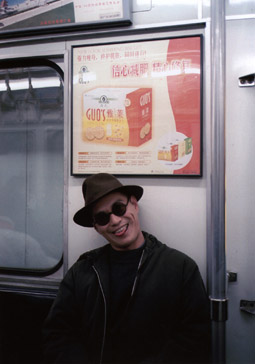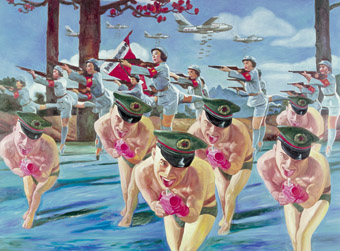Liberating the artist from the revolution
Linda Jaivin, artist Guo Jian

Guo Jian
photo Patrick Jones
Guo Jian
Guo Jian is a Sydney-based artist with an international reputation. Born in China in 1962, he trained as an artist, became soldier, participated in the Tiananmen protests of 1989 and came to live in Australia in 1992. Linda Jaivin interviews Guo Jian, and Trevor Hay (facing page), writing about Anchee Min’s second Jiang Ching-inspired work, Becoming Madam Mao, puts Guo Jian’s nightmarish, parodic and erotic model opera and ballet fantasies in context. KG
You used to employ a very personal iconography in your work—you painted your dreams and nightmares, the view from your hospital bed from when you had a broken leg, things like that. But over the years you’ve turned increasingly to a much more political and general symbolism. Why is this?
I used to have nightmares all the time. Violent nightmares. On reflection, I realised that there was something dark in my subconscious, something that was profoundly disturbing me. Then, in the library, I was looking at some pictures of China during the Cultural Revolution and I realised what was triggering these nightmares. Since coming to Australia 10 years ago, I’d pushed memories of my years in the Chinese army, and of Tiananmen, out of my mind. But seeing these images triggered memories, and once I started to use them in my paintings, I stopped having bad dreams. I felt compelled to continue. And it has worked; I’ve liberated myself.
Before my last trip to China, I wasn’t fully aware of my family’s history. My grandmother told me that the People’s Liberation Army had executed my grandfather. I had no idea. I was shocked. When the army arrived in Guizhou they accused my grandfather of being a landlord. He fled into the mountains. The soldiers trapped him in a cave. At the time, everyone in the mountains carried guns. My grandfather fired a shot, and hit a soldier in the leg. He was terrified and pleaded with the soldiers, many of whom were locals and knew him, to vouch for him. No one did. But they said, if you come out, we won’t kill you. The moment he stepped out, they shot him. Right in front of my grandmother.
My father was a soldier. He had to denounce his own father, knowing he’d be killed too if he tried to defend him.
And then in 1989, there I was, a former soldier, nearly killed by the PLA myself on Tiananmen Square.
Yet the images of the PLA in your painting have no hint of violence there at all.
That’s a really important point. Why did I become a soldier? Why did my father become a soldier? The army was a way to leave home, become independent. When I was little, all my toys were guns, and I had a miniature army uniform to wear. I was attracted by the image of the PLA. At the time I joined, the propaganda called soldiers “the most lovable people.”
Then there was The Red Detachment of Women (revolutionary model opera). I loved it. We all did. Why? Thinking back, it’s got to be all those women in shorts! At the time, in China, you never got to see women’s legs. But you could go to The Red Detachment of Women without anyone calling you a hooligan or suspecting your motives. In China, sexuality carries a negative connotation. You don’t admit to sexual desire. But even army propaganda used subtle sexual imagery to draw us in.
It was only after you got into it that you realised soldiering was all about violence. But the violence was legitimate! Revolutionary! It was exciting. I was just out of puberty. I thought, if I survive this, if I don’t get killed, I’m definitely going to get the prettiest girlfriend!

Guo Jian, Trigger Happy II
Private Collection, USA courtesy of Ray Hughes Gallery
Guo Jian, Trigger Happy II
Many of your recent paintings are done with the deliberate crudeness of propaganda poster art. Could you talk about that?
When I was little, my dad also made propaganda art. He made a Mao that glowed. We didn’t have TV. We’d just watch Mao. It wasn’t just us, either. Everyone in the village crowded in to stare at our glowing Mao. There were so many propaganda posters around when I was a kid, and I loved them. They were so colourful. Later, as a student at the Minorities Institute, I hated them, I thought they were vulgar. Then when I got into the army, the first thing they asked me to do was paint propaganda posters! Fuck me dead! (Laughs).
Now, I look at kitsch art and realise that’s what I was doing for years! The posters I was exposed to in my youth were very proper, very revolutionary, but the ones I’m creating are improper and satirical.
Not so long ago, you were rejected by prominent Sydney galleries including Sherman and Legge. Ever since showing at Tin Sheds in 1998, and winning first prize in the open section at the Fisher’s Ghost [a Campbelltown Art Gallery award, NSW] the same year, you’ve enjoyed extraordinary critical and commercial success. Your paintings have even decorated the main stages at the Big Day Out. How has this changed your life? Has it changed the way you think about your art?
The biggest effect it’s had on my life is that I don’t have to do any more labouring jobs! But I’m too busy working on my painting to think about how others see me. I rarely think about it.
When the Big Day Out asked me to design some posters on the theme of ‘chaos’, I didn’t know what to do. I’d seen a lot of pub rock, but I’d never been to one of those really big rock concerts. So they gave me a video of the last Big Day Out and the first thing I thought was—it’s like the Cultural Revolution! We didn’t have Woodstock, we had the Cultrev. But I still couldn’t come up with anything; I can’t paint to order. I have too many of my own stories to tell. So in the end they just chose images from paintings I’d already done.
Since coming to Australia, you’ve travelled around the country, hung out in pubs, gone to hear bands, played the pokies at RSL clubs, lived in sharehouses, listened to Triple J, and have friends who don’t speak Chinese. Why haven’t you incorporated any aspect of your Australian life and experience into your art? Or have you?
The paintings with water and the beach are influenced by Australia. I was knocked out by my first sight of the coast, of the beach. We don’t have any ocean in Guizhou. I love the sea. I still feel I’ve been here for too short a time, and I haven’t digested my Australian experience. Besides, I have to finish one stage in my life before I can start on the next. But you can see how bright the blues are in these paintings—that’s all from Australia.
If you were to describe your art in 3 words, what would they be?
Three words? Let’s see. Tacky…3 words? Where do you come up with these questions? (Laughs). Fun…and releasing. Tacky, fun and releasing.
This article appeared originally as part of the catalogue for Guo Jian’s exhibition Mama’s Tripping, Canberra Contemporary Art Space, Sept 9 – Oct 21, 2000. The interview is reproduced with permission of the author and CCAS.
RealTime issue #42 April-May 2001 pg. 8






